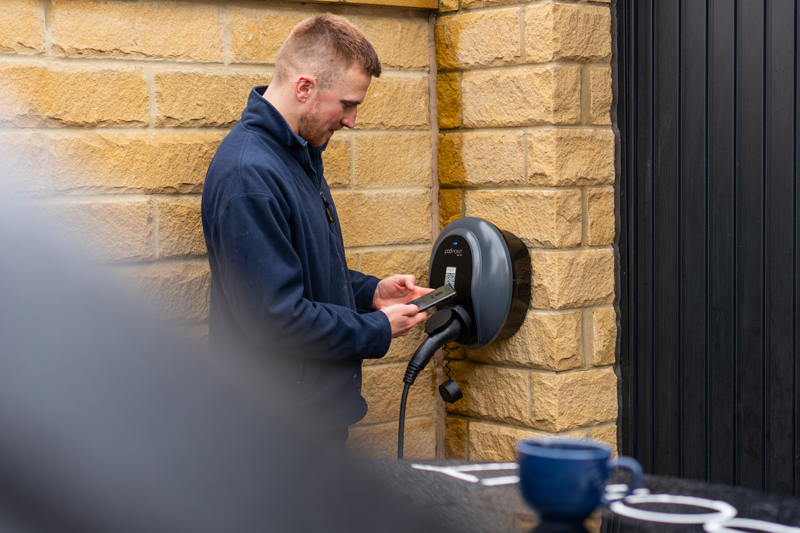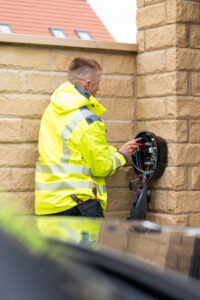
Pod Point’s Electrical Compliance Manager, Richard Townsend, provides an insight into what to consider before installing EV charge points.
We often receive requests from clients to retrofit EV charge points to an existing infrastructure, replacing their original equipment. That sounds like a simple process, almost a one-for-one swap, and in many cases, that’s usually not far off the mark. However, there are instances where a direct one-for-one replacement can’t be achieved, so we survey every retrofit case before committing to any such undertakings.
Always treat a retrofit as a new installation, surveying the existing infrastructure and equipment to ensure it meets legislative requirements. So, how do we start?
First steps
For any installation, always consider the basic BS 7671 requirements:
- Does the supply have capacity for an EV? (301)
- Will it need load management? (722.311.201)
- Are the main live and neutral supply conductors csa adequate? (132.6)
- What is the Earthing arrangement for the incoming supply? (TT, TN-C-S (PME), TN-S) (132.2, 301)
- Is the installation’s main earthing conductor csa adequate? (542.3)
- Does the charge point need diverted neutral current protection? (Open Pen) (722.411.4.1 iii, iv, v)
- Does the existing installation have adequate main and supplementary protective bonding in place? (411.3.1.2, 544.1, 544.2)
- Is the supply a looped and, if required, has the DNO been made aware?
- Has the DNO been made aware of the EV equipment install via their notification portal?
These are all basic requirements.
On top of these, each install also needs to be carefully designed to ensure that it meets the following requirements:
- Cable current carrying capacity (132.6)
- Has the customer agreed to fitting an SPD? (If not, have they signed a waiver?) (443.4.1)
- Is the capacity of any OCPDs adequate for the load/cable protection? (132.8)
- Are switchgear and enclosures used from the same manufacturer? (536.4.203)
- RCDs or RCBOs must be double-pole and disconnect both live conductors (722.531.3.1)
Next steps
So, we’ve established that the new or retrofit installation meets the requirements of BS 7671. Does this mean we’re good to go? Not quite.
There are requirements from multiple legislations that we need to consider before installation. Some things to look out for include:
Areas of natural beauty or cultural heritage
There are strict guidelines for installing in these areas. Most will need permission to ensure the resulting EV charge point doesn’t impact the region’s natural heritage. There may also be requirements placed on the eventual installation.
Listed properties
Depending on the level of a property’s category, the likelihood of being able to install will rest on permissions from the local planning authority. All properties and areas are unique, with varying compliance requirements.
Highways Act 1974
This is possibly the most important consideration for the placement of EV charge points. After we’ve addressed everything else, we must ensure that we don’t impact or contravene this Act, which requires that we don’t allow cables to cross or block public access or paths.
Some local authorities are more lenient to this requirement, provided the client takes full responsibility for any such practice. They’re all slightly different, so you need to check with the one applicable to where the installation will be.
Part M (Building Regulations England)
If it’s a new installation, has accessibility been taken into account? Depending on the use of the building or the EV charge point, the height at which the EV charge point has been located and adequate accessible space around the vehicle will need to be assessed. Devolved nations will also have similar requirements.
Proof of property ownership
Where parking for a proposed EV charge point is unclear, the land registry details and permission need to be sought from the client to ensure the installation doesn’t cause any ownership or legal issues later on.
Custom and practice
Where parking is not clearly defined, and locals seem to park in a way that doesn’t allow them permission, but everyone does it, in a secluded off-street gravelled area, for example, this can sometimes be seen as ‘custom and practice’. This means that everyone in a particular area parks in a non-designated way, so an EV charge point can be installed.
Custom and practice is challenging to confirm, and permissions from neighbours and local authorities must be sourced.
Any other permissions
Where properties share party walls, or where an allocated parking space is next to them or the boundaries of different properties, always ask for permission to install on a neighbour’s wall or property, as this can cause conflicts we want to avoid.
Disposal of waste
Whenever you retrofit, any waste must be disposed of responsibly; never use the customer’s refuse facility unless it’s clear that the waste is suitable and there is permission to use it. The equipment’s overall environmental impact and sustainability must be considered, particularly printed circuit boards (PCBs), which are always present in EV charging equipment.
Conclusion
Given the considerable power EV charge points can draw, the correct design parameters, including those for retrofit installations, must be met every time.
In addition, non-electrical permissions must be in place prior to any installation. Our advice is to review everything and ask the client for written permission if you feel it’s not a straightforward installation.
If you need technical help or advice, please don’t hesitate to contact us here at Pod Point. We’ll always give you the advice you need, whenever we can. Simply email: PodpointPE@pod-point.com
We’ll also be attending all the remaining ELEX events in 2025 and we frequently visit wholesaler events. Feel free to drop by for free advice and a catch-up.
Get more details about Pod Point’s range of EV charging equipment and services here
Find more industry technical articles here











